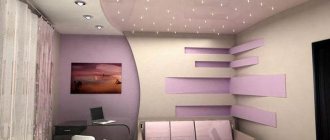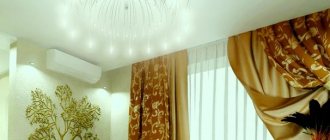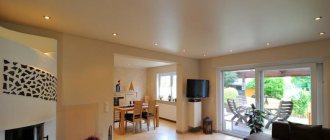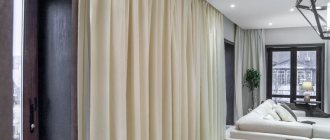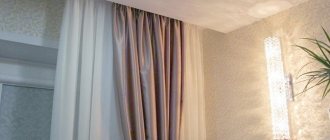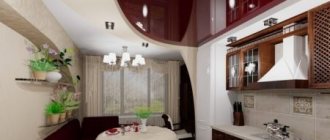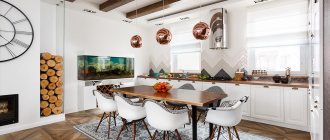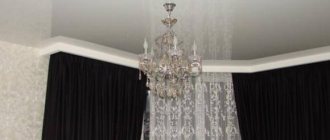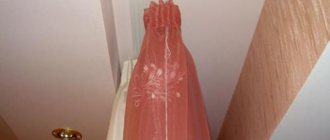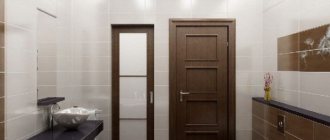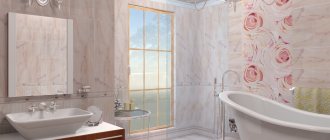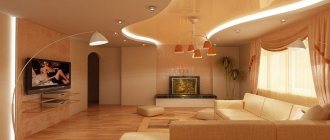Good lighting in a room is important. It is important to correctly position its sources so that the light is smooth and uniform, without going overboard with the number of devices. An original lighting option is a luminous ceiling. Modern techniques and technologies make it possible to create such an effect with minimal financial investment.
Stretch ceiling with lighting
Illuminated stretch ceilings can easily be considered the leaders among all luminous ceilings - a beautiful view at any time of the day, various lighting modes and a wide color palette make them so popular. We add here the ability to adjust the glow, which is also an additional advantage. Making such a ceiling with your own hands is not difficult. All you need is to have:
- film for stretch ceiling (matte, with transparency of about 50%);
- accessories for suspended ceilings;
- transformer (220/12 V);
- electrical wiring;
- screwdriver;
- aluminum tape;
- lighting elements;
- stepladder;
- electrical tape;
- indicator;
- construction hair dryer;
- building level.
Manufacturing begins with markings. First you need to mark a horizontal line around the entire perimeter of the room. All ceiling panels will need to be secured along this line. But this is all much later, since now it is necessary to mount the lighting in a high-quality manner. For this purpose, we cut the aluminum tape into strips, the length of which will be equal to the width of your room. These strips will become a kind of reflector for light, which will allow the illumination to be uniform. For the same purpose, all strips must be attached to the ceiling at a distance of about 30 cm. If you do this at a greater distance, you risk getting a mattress effect, and the light strips on the ceiling will become annoying after a while. Already attaching strips to the ceiling is also not always good, since you will end up with a ceiling that is too bright.
Universal Profile Apply
Based on it, you can assemble four types of products:
- floating ceiling
- light lines
- floating lamp
- curtain rods
It fits easily with all other profiles. In this case, the screws in it are screwed into the technological cavity and do not end up in the visible light zone.
But most importantly, if your light line runs along the perimeter of the ceiling, you can easily adjust and set the width you need.
When assembling a floating line in the center of the room, two such universal profiles are combined into one with self-tapping screws.
And even here it is possible to adjust the width of the luminous line.
To create a floating backlight from 10cm and wider, you will already need a plastic insert.
With such a universal thing you can assemble quite complex figures.
Light source for such a ceiling
So, let's look at what kind of light source you can use to create a glowing top of the room. The most ideal option for such a source is LED strips.
It is thanks to them that we can make sure that light is created in many places and, as a result, we receive uniform illumination. If you use several powerful lamps, then in some places the luminous top of the room will be brightened to a greater extent, and in others - to a lesser extent. That is, its glow will be uneven.
Helpful advice: light bulbs can be used when there is a certain image on the plastic, canvas or glass. As you know, an image has light and dark areas. In other words, one object is well lit, while the other is in the shadows. Above the first object there may be one or more light bulbs. Ultimately, everything should turn out so that the dark part of the image, which may have a luminous ceiling, should be perceived as a design idea.
How to make a luminous ceiling suspended structures
One of the best options for making a luminous ceiling can be considered a suspended structure behind which light sources are placed. Moreover, it should be more than one light bulb that can illuminate a small space within a radius of 15-30 cm around itself. You'll have to think of one that can emit light even in the farthest corners of the room. The best solution for this task is one that is located in stripes over the entire area of the ceiling, and not just in the center or on the sides.
We have decided on the light source. Now you need to think about what material is capable of transmitting light rays without being deformed by the heat emitted by the lamps. This function can be assigned to PVC film, in other words, done. It should be noted here that fabric is not suitable for these purposes; you need to choose film.
- A stretch ceiling is an ideal option for creating a beautiful covering, perhaps even with a pattern depicted on it, which will be illuminated from the inside. This lighting option can even be used as main lighting.
Glowing stretch ceiling photo
- – this option is associated with large financial costs, because making blocks from tempered glass, bringing them to the site and installing them will not be cheap. Although the external effect of the glass luminous ceiling is impressive. Using this method, as well as the previous one, you can create the effect of daylight pouring from the ceiling.
- Stained glass ceiling is a type of glass ceiling. Only in contrast to him, some actions are played out, drawings are depicted that carry a certain subtext. Currently, matte light ceilings with a transparent pattern, which are made by sandblasting mirrors, are relevant. Classic stained glass windows illuminated from the inside are also popular.
Stained glass ceiling with lighting photo
- with lighting - this method will not allow illumination of the entire surface of the ceiling, because plasterboard does not transmit light. To install such a ceiling, niches or shelves are made on which the LED strip is fixed. But in this case, you can’t count on bright (main) lighting, because the light ceiling will be diffused, directed to the sides and not down. This is just a decorative technique that can diversify the interior.
Glowing ceiling photo
- Light panels are also used in outdoor advertising. These are individual square or rectangular segments made of high-throughput acrylic glass, on the back of which LED bulbs are attached (they are located close to each other). Thanks to this arrangement of lamps, the panels emit uniform light and can be used as main lighting. From a decorative point of view, the advantage of this method is that you can assemble the ceiling from panels of different colors.
Light panels create a uniform light space, in contrast to suspended ceilings with a built-in light strip. Why? In the panels, the bulbs are located close to each other, so they emit a uniform glow. And the LED strips behind the tension fabric are arranged in stripes, and these stripes are visible through the PVC film.
Stretch star ceiling
Stretch star ceiling
The process of arranging such lighting is in many ways similar to the installation of a starry sky in combination with the suspended ceiling discussed earlier, but it has a number of important features and differences. Follow the instructions below in sequence.
Stretch star ceiling
First stage. Attach a light projector to the rough base.
Second step. Install profiles around the perimeter of the room for installing a stretch ceiling. Mount profiles with a 50-70 mm gap from the base.
Third step. Prepare a projection of the luminous composition onto the base on sheet plastic or plywood. For greater convenience, you can use nets made of fishing line.
Fourth step. Make holes in the blanks and insert several threads into each finished hole.
Fifth step. Attach the finished false ceiling (sheet material and threads) to the rough ceiling. Connect the threads to the projector.
Sixth step. Install the stretch ceiling sheet.
Seventh step. Turn on the light generator, find the ends of the drawn threads and make holes in the ceiling fabric in the designated places. To create the holes, use a small soldering iron with a thin wire on the end.
Ceiling starry sky
Eighth step. Pull out the threads and trim off the excess length.
You don’t have to create holes in the stretch fabric, but in this case the effect of the backlight will be less bright.
Additionally, you can integrate reflectors and LEDs into the design to imitate large stars.
During the installation process, provide a hole in the ceiling through which you can later service the light generator. To do this, you can install a plasterboard structure around the perimeter of the room.
Stretch ceiling starry sky
Photo examples
To complete the picture, it is worth giving a few examples. Below are descriptions with photo examples of possible solutions for the home. Among them there are both standard patterns and original compositions.
For kitchens
The kitchen is the brightest room in the apartment. It is impossible to cook food at dusk, so it is necessary to provide a powerful luminous flux. It is better to zone the room - a separate place for cooking and eating. The “I” and “K” systems are very popular.”
The second option is suitable for large rooms. There is a line of lamps in the center, and other lines of light radiate from it. This way you can flood the entire room with light.
It is important that the work area is well lit. Lamps in the kitchen can be placed in the letter L, pointing to the cutting table. In large rooms, a chandelier is often installed above the dining area to distribute light evenly.
For the hall
The main room in the apartment should have cozy lighting that will make it pleasant to be inside. The classic option is the main lighting in the form of a chandelier and auxiliary lighting. Stretch ceiling designs with spotlights and chandeliers are common due to their simplicity and efficiency. In such a room it will be pleasant to watch TV, read, communicate with family and friends.
Lamps in the living room can be arranged arbitrarily or according to your design. The uneven distribution of light allows for zoning, creating separate areas for relaxation and work. The scheme is common in studio apartments where there is a lot of space.
For the bedroom
The bedroom is a place to relax. Therefore, lighting should be moderate and soft. When using classic LED spot systems for suspended ceilings of type E (8 points) or H (11 points), harmonious lighting is achieved. It is recommended to add a dimmer for dimming. Smooth control allows you to set the mode of reading, sleeping, relaxing or watching TV.
The placement of lighting requires harmony with the interior design. The bedroom is the most decorated room, so the light will reflect the palette of the overall atmosphere.
For children's room
A children's room is a multifunctional room, which is characterized by clear zoning of a play area, a place to study and sleep. It is recommended to install powerful points above the table that can provide the required amount of light. In order not to spoil the view, you can install an additional table lamp.
A place to sleep does not require strong lighting, so a wall lamp will do. This element will create a warm and relaxing atmosphere. Can be used as a night light or for reading before bed.
It is not recommended to install a hanging chandelier as a child may break it while playing. The point system will completely eliminate the need for a chandelier.
For the hallway
There is no need to install efficient lighting in the hallway, so there is no need for a central chandelier. Houses and apartments with low ceilings will not allow you to turn around, which will limit you.
A convenient way to organize would be to install spotlights along the perimeter walls. In a narrow corridor, it is best to install a line of lighting fixtures along the entire length. The small space will be well lit and you will not feel any discomfort. On multi-level ceilings you can create a beautiful composition of dots.
For bathroom
In panel houses, the bathroom is small, so there are not many algorithms for lighting equipment. System “B” is considered the classical organization of light. You can install a wall lamp near the mirror.
In spacious rooms you can give free rein to your imagination. For example, multiple stitch lines are often installed. Zoning emphasizes the spaciousness of the room, visually increasing its area.
Advantages and disadvantages of ceilings without lighting elements
Skeptics grin when reading these lines. But you know that absolute darkness does not exist, so a slight glow from the ceiling will be constant. But the constantly changing light outside the windows will allow the colors to shine at full strength. We also take into account the fact that when the angle of incidence of the light beam on the paint changes, the degree of luminescence will change. And this is a very significant plus of the ceiling, since it will not bother you with its monotony.
There is only one drawback: the colors are not always bright (the quality of the paints is not always high), and such paint does not last long. The main advantage is the exclusivity of such a ceiling, since you can paint it at your own discretion. And you don’t have to have artistic abilities to do this. You just need to have the mentioned paints, brushes of different sizes and a primer for the ceiling.
Glowing ceiling using stickers
The modern market is very saturated with luminous stickers, which can be successfully used if you want to create a ceiling with your own hands in a children's room. Such elements are easy to glue, they are very inexpensive, and changing their position is also very simple. And they are “charged” from any light source, even from an ordinary light bulb. One hour of light consumption is equal to two to three hours of constant soft glow for the mentioned elements.
They most often emit rays of a light green color, but if desired, the spectrum can be significantly expanded, since other color solutions are increasingly appearing. There is still one drawback - a loose fit to the ceiling surface. Either there is something wrong with the adhesive base, or the ceiling requires pre-treatment. The way out of this situation is simple - use double-sided tape. First, a piece of tape is glued to the sticker, and only then the element is pressed tightly against the clean surface of the ceiling. We remind you that when gluing all the elements in the room there must be normal humidity, otherwise the tape will not firmly hold the luminous figures. At first glance, there is nothing wrong if one (or several) elements fall off. But if this happens at night and the fall hits the person’s face, then instead of the calming effect of the ceiling, you will get additional sleepless nights. Otherwise there are no problems. Except that in the daytime such a ceiling looks rustic.
Expert advice on selection and installation
When choosing options for installing lighting from the inside or outside, you should remember that strips that are too long require a lot of energy and fail faster. It’s easier to cut one element into several small ones; the guideline is the dotted line that complements all systems.
When arranging curved structures, you cannot bend the tape too much; a bending radius of more than 20 mm will lead to a defect in the diodes and they will not burn. When connecting, pay attention to the polarity, but testing the lighting system is carried out after the controller is connected.
Tape with a reverse adhesive side adheres better to a degreased surface. If there is no adhesive layer, double-sided tape will do; on metal, the tape is placed on an insulating backing - this will prevent possible defects in the lighting.
Installation of lighting system
Now you need to mount the main element of the ceiling - the lighting system. You can use both neon bulbs and LED strip for this. There are a large number of them on sale, so choosing will not be difficult. The peculiarities of all these lighting elements are that they consume very little electrical energy, have a long service life and do not heat up (virtually) during operation. The last point is one of the most important, since you absolutely do not need a fire hazard in the apartment.
Attaching the lighting strip to the LEDs is simple. The main thing is that the contact wires from it are located near the power source. It is often advised to mount the transformer directly on the ceiling. This makes sense only when you do not want the supply wires to be hidden from prying eyes. There is nothing more to add to this, since for other reasons this arrangement of the transformer is inferior. First, if any repairs are needed, you will have to work very hard to get to them. And secondly, the transformer releases a large amount of thermal energy, and when using the backlight for a long time, you risk that the temperature above the suspended ceiling will rise and the ceiling membrane will deform.
It makes sense to place the transformer somewhere close so that it is easy to reach. In this case, the supply electrical cable must be laid in a special box or the wall must be grooved and the cable must be laid in the resulting inner box, and only then this cavity must be plastered.
An interesting way to decorate a living space is a luminous ceiling. Thanks to its decorative qualities and originality, it is now at the peak of popularity.
You can diversify the interior in different ways, but one of the most spectacular is the continuous flow of light pouring from above the room. To bring this idea to life, you will have to make a suspended ceiling and hide the light source behind it. What types of such structures exist and what materials are used to make a luminous ceiling? Let's talk about this together with Dream House.
Glowing ceiling as the main lighting photo
Examples in the interior
Designers really like this lightweight and flexible material, as it allows them to show creative imagination and taste, highlight the necessary areas in rooms, highlight ceiling niches and projections, and diversify lighting solutions.
In a high-tech style living room, soft lighting of the walls and complex ceiling looks great. It emphasizes the ideal geometry of the walls, adds originality and complexity to the overall lighting of the room, and the walls acquire delicate shades. The light flows smoothly and softly, does not hurt the eyes, the room has a comfortable and cozy atmosphere of peace and relaxation.
Thanks to the translucency of the ceiling fabric, the LED circuit, laid in a pattern above the surface of the ceiling, shines through it with dim and muted light, drawing amazing patterns above your head. As soon as you press the switch button, the room is transformed, immersed in an atmosphere of magic and romance.
Diverse lighting includes lamps located on the ceiling and walls, a ceiling chandelier and slitted lighting of the tension fabric. Together they highlight the central area of the living room interior with light.
Drawing attention to bright decorative elements and placing visual accents, lighting creates a unified ensemble and emphasizes the luxury of the interior.
For information on how to mount an LED strip on a suspended ceiling, see below.
Glowing ceiling description, features, installation technology. Glowing stretch ceiling
The installation of a stretch ceiling provides almost limitless possibilities for decoration. The most effective technology for organizing luminous coatings is considered
It is important to take into account the difference between this approach and the implementation of classical lighting, which includes incandescent lamps. A high-quality luminous stretch ceiling makes the room more expressive and attractive from a design point of view.
If previously the ceiling surface remained on the outskirts of the interior, then thanks to stretch fabrics and the inclusion of decorative elements the situation has changed radically.
Procedure for applying luminous paints
First, clean the surface from dust and apply a small layer of primer to it. The dried primer allows you to apply the design. You can draw a star simply: dip the brush in paint, remove excess paint on the edges of the container and point the brush perpendicularly to the ceiling. The bristles should spread out to the sides and form small rays on the surface. We make the stars with brushes of different sizes (then the stars will be different) and use paints of different colors for this. Well, we draw comets in the same way, but at the final stage we move the brush along an arc. To create such a ceiling with your own hands, you only need the ability to draw the moon. But even a person who has never held a brush in his hands can cope with this work.
Stretch ceilings and their installation
- First way
– it’s always fascinating.
They are made from PVC optical film with 50% transparency. The installation technology is the same as that of a standard stretch ceiling. An LED strip is used as a light source. It can be monochrome or have RGB colors. Positive points:
— Low energy consumption; — Long service life; — Low heating temperature; — Predominance of yellow to white flowers; — Luminous stretch ceilings can be powered by auxiliary equipment, and this is an additional color scheme. Negative points:— Financial component. Material and its components:
— Wire 2x0.75 (two-core cable, for example, ShVVP). The amount of wire is affected by the type of LED strip and the installation process; — LED strip: can have one or several RGB shades, light flux – 4000 lm; — Transformer for 220v or 12v; — Controller – required when using multi-color RGB tape; — Plank, usually aluminum. Preparatory work:
— Make markings on the ceiling to attach the aluminum strip; — Cut the aluminum strip into pieces. They must be equal to the transverse length of the base ceiling; — Lay wires to the transformer installation site; — Cut (connect) the LED strip; - Disconnect the entire room from the network - usually done in the main panel. Installation work:
— Attach the aluminum strip to the ceiling, following the markings. Step – 300 mm; — Attach it to the bar, selecting its desired length in advance; — Connect the wiring to the transformer. Use a special controller or switch; — Turn on the circuit breaker and start the structure (use a switch or controller). Advice
: To achieve the best effect, fasten the strips in 300mm increments. This is necessary so that the line of LEDs is not noticeable from the room.
- Second way
Suspended luminous ceilings are also made from aluminum panels.
Then photo printing is applied to order. In this case, the main light source is an LED or fiber optic. Standard panels are a disk, 5 mm thick and 1.2–1.5 m in diameter. The lighting effects are controlled using a control panel. Material and its components:
— “Starry Sky” disk with built-in LEDs; — A control panel with a controller that allows you to change the brightness of the LED elements; — The controller and control panel are responsible for the twinkling of stars and the movement of meteors. Installation work: The installation process usually does not take much time. In terms of complexity, installing LEDs is the same as installing a regular chandelier. All fasteners are included in the lighting design kit. All you have to do is run the cable to the central part of the panel.
Light lines in a square
When assembling luminous squares and rectangles from standard profiles from Flexi, this same square is pre-assembled on the floor.
Based on the measurements taken, cut four sections at a miter angle at 45 degrees.
Next, join them together. You can use nails bent at 90 degrees as guides.
Then firmly fix the structure at the corners with self-tapping screws.
Check the diagonals.
Next, this light square rises to the top and is fixed there at the corners.
The general principle of assembling the supporting frame is something like this. But still, let's look in detail at the simplest option in the form of one straight line from wall to wall.
Selection of LED strips
It is worth noting that LED strips are characterized by different brightness levels. So, SMD 3528 is less bright than SMD 5050. The actual choice of brightness depends on your preferences.
Helpful advice: if you install a suspended ceiling using plasterboard blocks (they usually go along the perimeter), then to create lighting you need to choose high-quality tapes. They have to work for a long time.
This is necessary from the point of view that in the event of their breakdown, it is necessary to dismantle and reinstall the drywall and PVC film. And this is a complicated procedure
This nuance is also important: PVC film transmits light by 50 percent. At the same time, it changes the shade of light. It becomes softer by 500-1000 Kelvin. To create a daytime white tint, the LED strip must create light with a temperature of 5-6 thousand Kelvin. The warm-white device involves the use of LED strip with a temperature of 3.5-4.5 thousand Kelvin.
Installation of LED strips
And so, the first stage during which a luminous ceiling is created is the installation of LED strips on the surface of the uppermost plane of the room. They are placed next to each other.
If the PVC was manufactured in Germany, the distance between the tapes should be 15-17 centimeters. The distance from them to the PVC sheet should be 14 centimeters. If the space between the LED strips and PVC is smaller, you will get a “zebra” effect.
When luminous parts of the ceiling sheet are arranged to illuminate a room that has a low ceiling, this distance can be reduced. But in this case, LED strips should have less power and should be placed more densely.
Helpful advice: when using PVC manufactured in other countries, it is recommended to make preliminary calculations of the pitch of the tapes and the distance between them and the PVC. To do this, you need to take two LED strips and a canvas (preferably with dimensions of 20x20 centimeters or more) and experimentally determine the required values.
When creating our internal suspended ceiling lighting, it is better to install the LED strip on a special lattice platform. First, strips of PVC plastic are installed along the ceiling surface (its width should be from 5 to 10 cm).
Next, aluminum plates are attached to these strips across this surface. The LED strip is attached to the latter. After this, connect the power supplies, controller, RGB amplifiers and install drywall and PVC film.
It is desirable that in addition to PVC film there are also plasterboard boxes. You can place the following elements in them:
- wiring;
- Power supplies;
- controller;
- RGB amplifiers.
In the case of installing an Armstrong-type ceiling, the luminous part is done in a similar way. The only difference is that the squares made of glass or plastic will glow. These squares are very easy to remove.
Principle of operation
0.2 mm of dielectric is applied to the flexible tape, contact pads with LEDs are attached at the same distance, resistors are installed that limit the energy consumed - this is LED backlighting.
Each LED strip consists of modules of the same length (up to 10 cm). Segments of 5 meters in length are rolled into snails (into bobbins), cut-off points are made at a certain distance, and the circuit board is cut at them. Often, double-sided tape is glued to the back of LED modules, which greatly simplifies installation. LED lighting requires a constant electric current to operate. Available in monochrome. polychrome LED strips.
Luminous ceiling wallpaper
We can’t forget about the special ceiling wallpaper. They are also available in different types and may contain reflective elements and fluorescent paints. Such wallpapers “work” in the same way as described earlier. Gluing them to the ceiling will not be difficult; you don’t have to worry about elements falling off. Wallpaper, which appeared on the market of finishing materials quite recently, looks more elegant on the ceiling.
The process of their production is kept secret by manufacturers, but it is simple to describe them: the composition of the wallpaper includes the finest silver threads, formed in the form of certain patterns. These threads begin to emit a slight glow in the dark. This glow can be adjusted remotely.
Making a ceiling with your own hands using such wallpaper is very simple; you just need to glue it according to the instructions on a smooth and primed surface of the ceiling. Strangely enough, such a ceiling has the most disadvantages: wallpaper is expensive, the design can get boring very quickly, since it is not able to change depending on certain conditions. But the most frightening thing is that the wallpaper production technology is not disclosed - you never know what could be in their composition. What if excess humidity appears in your apartment (and this cannot be ruled out)? What will happen to the expensive wallpaper on the ceiling then?
These lines cannot be considered as anti-advertising of the product; rather, they are expressed by the unknown principle of operation. But if you want to decorate the ceiling with your own hands using wallpaper with silver threads, then you need to inquire in more detail about their composition and operating principle from distributors (trading companies). They are required to provide information about the product and have an appropriate quality certificate for the specified goods.
Multi-level plasterboard ceiling with spot light
Ceilings that have their own lighting sources are considered more reliable and beautiful.
The simplest of them can be considered multi-level plasterboard ceilings, into which spotlights are mounted horizontally located deep within a certain level (or several levels). They will not create the illusion of a starry sky, but in the daytime they will look like a real work of art.
This trend in home interior design existed several decades ago and remains relevant to this day. The only disadvantage of such ceilings is the need to frequently wipe the installation sites of lighting elements (dust always accumulates near them).
Flexy profile
This manufacturer widely uses the PF 3645 or PF 6838 profile.
With its help, it is easy to divide the ceiling into sectors, or create rectangular structures.
You can choose a narrow or wide option for two ribbons.
The disadvantage is that it is quite problematic to create a high-quality light segment in the middle of the ceiling. Mainly used for wall-to-wall installations.
